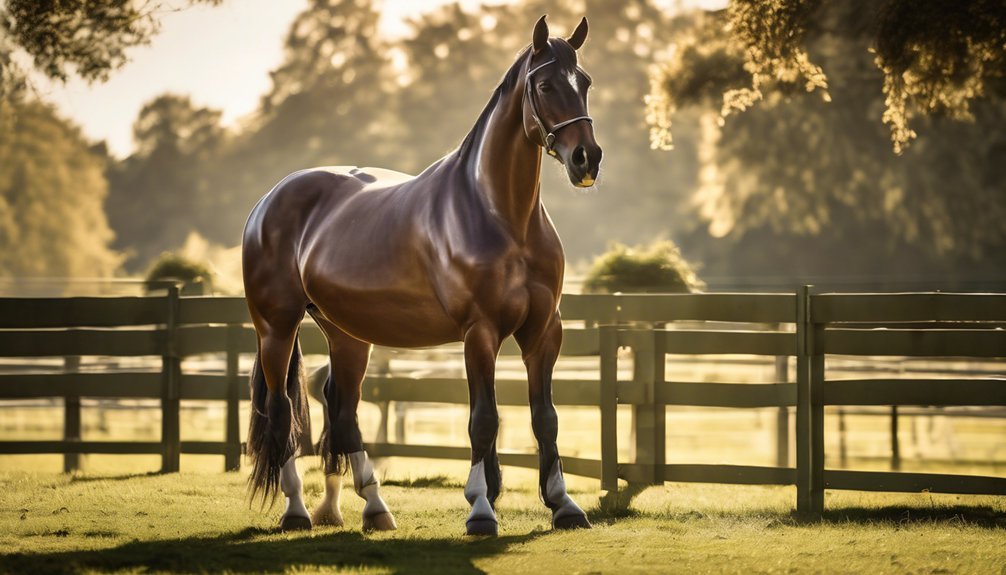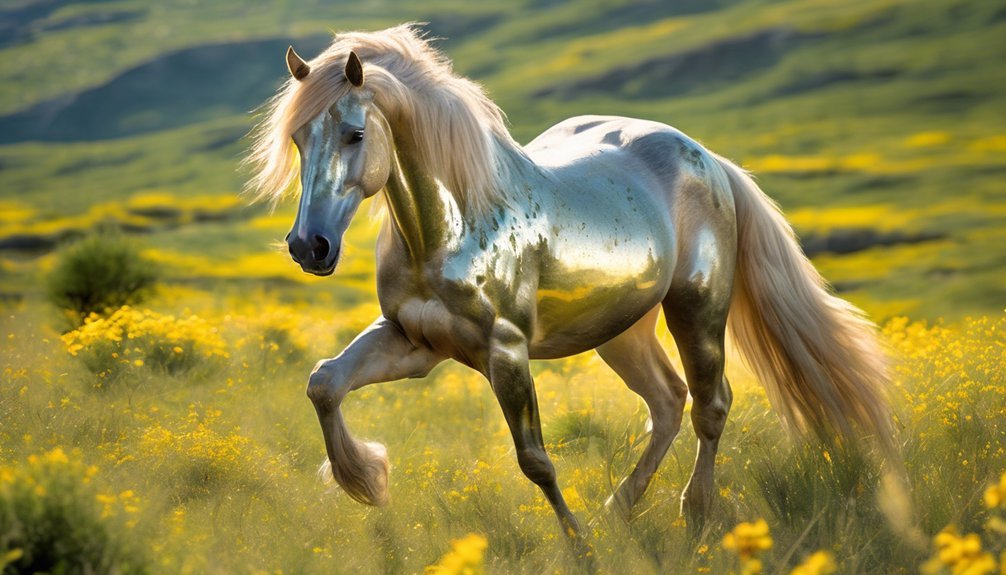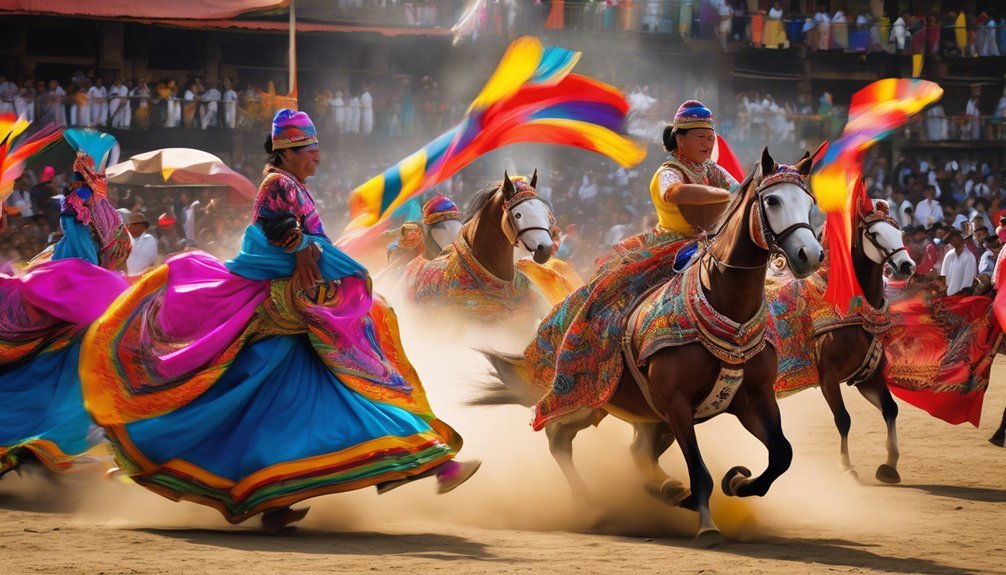
You might not realize that the horses we admire in show arenas today were once essential workhorses, vital for agriculture and transport. As society evolved, so did the focus of breeding practices, shifting from strength and endurance to speed and elegance. This transformation reveals much about our changing relationship with these magnificent animals, and the advancements in genetics are only the beginning of this fascinating journey. What's next for equine breeding and competition?
Key Takeaways
- Horses historically served as essential workhorses in agriculture and transportation, symbolizing power and social status in various cultures.
- Industrialization shifted horse breeding focus from strength and endurance to speed and agility, transforming their role from workers to competitors.
- Advancements in genetics and breeding techniques improved health predictions and performance insights, enhancing breeding decisions and overall horse quality.
- In Vitro Fertilization (IVF) allowed for selective breeding and preservation of rare breeds, reflecting changes in horse valuation from utility to aesthetics.
- Modern ethical breeding practices prioritize animal welfare, genetic diversity, and sustainability, fostering trust and engagement within the equestrian community.
The Historical Role of Horses in Human Society

Throughout history, as societies evolved, horses have played a pivotal role in shaping human civilization. They've been more than mere beasts of burden; their cultural significance runs deep.
You'll find that horses symbolize power, freedom, and nobility across various cultures. From ancient myths to modern media, equine symbolism reflects our aspirations and dreams. Think of the majestic stallion often depicted as a hero, embodying strength and grace.
In many societies, horses have also represented social status, influencing trade and warfare. Their presence in rituals and art underscores their importance, binding communities together.
As you explore this intricate relationship, you'll see how horses haven't only served practical needs but also enriched our emotional and spiritual lives, leaving a lasting legacy.
Early Breeding Practices and Their Purposes
As horses became integral to human society, early breeding practices emerged to enhance their utility and value.
These ancient practices were driven by specific breeding purposes, shaping the horse's role in daily life. You'd find that breeders focused on:
- Strength: Selecting powerful horses for heavy labor, ensuring they could handle demanding tasks.
- Speed: Choosing swift horses for transportation and racing, meeting the needs of travel and competition.
- Temperament: Prioritizing calm and trainable horses, crucial for work and companionship.
- Endurance: Breeding for stamina allowed horses to cover long distances, vital for trade and communication.
These practices not only improved the horses' capabilities but also reflected the evolving relationship between humans and these magnificent creatures.
The Impact of Industrialization on Horse Breeding
With the advent of industrialization, horse breeding underwent a profound transformation that redefined the relationship between horses and humans.
The industrial revolution introduced mechanized agriculture, dramatically reducing the need for workhorses. As machines took over tasks once handled by these noble animals, breeders shifted their focus. Instead of prioritizing strength and endurance for labor, you began to see an emphasis on speed, agility, and specific traits for various equestrian pursuits.
This shift not only changed breeding practices but also the very essence of horse ownership. Horses became more companions and competitors than essential workers, paving the way for a new era in equestrian culture.
You can see how these changes laid the groundwork for the modern horse industry we know today.
The Rise of Competitive Equestrian Sports

Competitive equestrian sports have a rich history that dates back centuries, shaping the way we view horse breeding today.
With the Olympic Games showcasing top-tier talent, these events have sparked increased interest in various breeds and disciplines.
You'll see how the popularity of breed shows further propels this evolution, influencing breeding practices and rider aspirations alike.
Historical Origins of Equestrian Sports
While many might think of equestrian sports as a modern phenomenon, their roots stretch back to ancient civilizations where horses played a pivotal role in both warfare and transport.
Equestrian traditions emerged as societies began to recognize the beauty and skill involved in riding. Ancient competitions showcased not just the utility of horses, but also their grace and power.
Consider these key aspects of their evolution:
- Chariot Racing in ancient Rome and Greece highlighted speed and strategy.
- Jousting during the medieval era displayed bravery and knightly prowess.
- Dressage has origins in military training, emphasizing precision and control.
- Show jumping evolved from practical riding skills, reflecting artistry in movement.
These competitions laid the groundwork for today's dynamic equestrian sports.
Impact of Olympic Games
The Olympic Games have significantly shaped the landscape of equestrian sports, elevating them from ancient competitions to a platform of international prestige.
You can see the profound impact of this Olympic legacy on the evolution of equestrian disciplines. With the inclusion of show jumping, dressage, and eventing, equestrian sports have transformed into highly competitive arenas, attracting top riders and horses from around the globe.
The rigorous standards set by the Olympics have pushed breeders to refine their stock, enhancing performance and temperament. This shift not only showcases the beauty of these majestic animals but also fosters a deeper connection between rider and horse.
As you witness the thrill of Olympic competition, you're witnessing the pinnacle of equestrian evolution and dedication.
Popularity of Breed Shows
As equestrian sports gain momentum, breed shows have emerged as a dynamic avenue for showcasing the distinct qualities of various horse breeds.
You might notice several breed show trends reshaping the competitive landscape:
- Increased Participation: More enthusiasts are entering the ring, eager to highlight their horse's unique attributes.
- Diverse Events: From halter classes to performance categories, there's a show for every breed and skill level.
- Evolving Judging Criteria: Judges now focus on a broader spectrum of traits, placing emphasis on temperament and conformation.
- Community Engagement: These events foster connections among breeders, owners, and fans, strengthening the equestrian community.
With each show, you witness the dedication and passion that drives the sport, enriching the experience for everyone involved.
Advancements in Genetics and Breeding Techniques
As you explore the world of horse breeding, you'll discover how advancements in genetics and breeding techniques are transforming the industry.
Innovations in genetic testing allow breeders to make informed decisions, while selective breeding methods enhance desirable traits in horses.
Additionally, in vitro fertilization is revolutionizing the way you can produce high-quality offspring, opening new avenues for breeding excellence.
Genetic Testing Innovations
Recent advancements in genetic testing have revolutionized horse breeding, offering breeders powerful tools to enhance their stock.
With innovations in DNA sequencing, you can now unlock insights that were once unimaginable.
Here are four key benefits of these genetic testing innovations:
- Enhanced Genetic Diversity: You can identify genetic markers that contribute to diversity, improving the overall health of your horses.
- Health Predictions: Testing helps predict potential genetic disorders, allowing for better breeding decisions.
- Performance Insights: You gain access to data that highlights traits linked to performance, helping you choose the best matches.
- Optimized Breeding Plans: With detailed information, you can create more effective breeding strategies tailored to your goals.
Embracing these advancements can lead to a brighter future for your breeding program.
Selective Breeding Methods
Building on the insights gained from genetic testing, selective breeding methods have evolved significantly, allowing breeders to make more informed decisions than ever before. Today, a focus on genetic diversity ensures that you're not only selecting for performance traits but also maintaining the overall health of your horses. Ethical considerations are paramount, guiding you to balance ambition with responsibility.
| Trait | Importance | Ethical Consideration |
|---|---|---|
| Performance | Competitive edge | Avoiding extreme traits |
| Temperament | Trainability | Ensuring welfare |
| Health Resilience | Longevity | Preventing genetic defects |
| Conformation | Aesthetic appeal | Maintaining diversity |
| Genetic Diversity | Population health | Ethical breeding practices |
With these advancements, you can confidently shape the future of horse breeding while honoring ethical standards.
In Vitro Fertilization Impact
While the traditional methods of horse breeding have laid a strong foundation, the introduction of in vitro fertilization (IVF) is revolutionizing the landscape.
These in vitro advancements in equine reproduction are opening doors to unprecedented possibilities, enhancing both genetic diversity and the quality of offspring.
Here's how IVF is making an impact:
- Genetic Selection: You can now choose specific traits, improving overall breed quality.
- Increased Success Rates: IVF often results in higher conception rates compared to conventional methods.
- Preservation of Rare Breeds: It allows for the preservation and revival of endangered horse breeds.
- Reduced Stress on Mares: The process minimizes the physical toll on breeding mares, promoting their health.
Embracing these innovations can transform your breeding program into a champion legacy.
The Shift in Equine Valuation: From Utility to Aesthetics
As the world of horse breeding evolves, you may notice a significant shift in how we value these magnificent animals, moving from a focus on utility to an appreciation for aesthetics.
Once, valuation criteria centered around strength and endurance, essential for workhorses. Today, aesthetic preferences reign supreme, with breeders prioritizing traits like conformation, coat color, and movement.
You're likely to find that a horse's beauty or unique features can elevate its worth far beyond its functional abilities. This transformation reflects broader societal changes, where visual appeal often influences emotional connections.
As you explore the current landscape, you'll see how this shift not only redefines horse breeding but also reshapes the relationships we build with these animals.
The Modern Landscape of Horse Breeding and Competition

The modern landscape of horse breeding and competition is a vibrant tapestry woven from tradition and innovation. As you navigate this dynamic world, you'll notice a strong emphasis on genetic diversity and breeding ethics.
Here are four key aspects shaping today's environment:
- Technological Advances: Genetic testing helps breeders make informed decisions, enhancing horse quality.
- Ethical Considerations: Responsible breeding practices prioritize animal welfare and sustainability.
- Diverse Disciplines: From dressage to endurance, competition avenues have expanded, allowing varied expressions of equine talent.
- Community Engagement: Breeders and competitors foster a collaborative spirit that encourages knowledge sharing and growth.
As you immerse yourself in this rich arena, remember that every choice you make impacts the future of equine excellence.
Frequently Asked Questions
What Breeds Are Considered the Top Show Champions Today?
Today, Arabian horses, Thoroughbreds, Warmblood breeds, and Quarter Horses dominate the show champion scene. Each breed brings unique qualities and talents, captivating audiences and showcasing the incredible bond between horse and rider in competition.
How Has Horse Breeding Affected Horse Health and Welfare?
Horse breeding impacts health and welfare by influencing genetic diversity. You should consider breeding ethics to ensure animals thrive, as selective practices can lead to inherited issues, compromising their overall well-being and longevity.
What Are the Most Common Horse Breeding Myths?
Imagine a tapestry woven with threads of myth—breeding misconceptions abound. You'll find myth debunking reveals that coat color doesn't ensure talent, and thoroughbreds aren't always the best choice. Knowledge empowers your decisions in horse breeding.
How Do Environmental Factors Influence Horse Breeding Practices?
Environmental factors, like climate changes and habitat availability, shape your horse breeding practices. You adapt to these influences, ensuring your horses thrive in their surroundings, ultimately impacting their health, temperament, and overall breeding success.
What Are the Costs Associated With Competitive Horse Breeding?
When you engage in competitive horse breeding, you'll encounter significant breeding expenses and training costs. These financial commitments can add up quickly, impacting your overall investment and determining your success in the competitive equestrian world.
Conclusion
As you reflect on the evolution of horse breeding, consider how the transition from workhorses to show champions mirrors broader societal changes. The theory that competitive sports can enhance breed quality gains traction, as the demand for elite performance drives innovation. By embracing advanced techniques, breeders not only prioritize health and talent but also redefine equine beauty. This ongoing transformation highlights our complex relationship with horses, revealing how they continue to inspire, serve, and captivate us in new ways.





